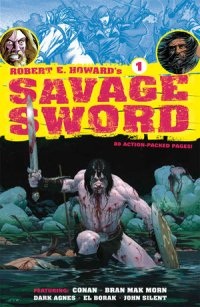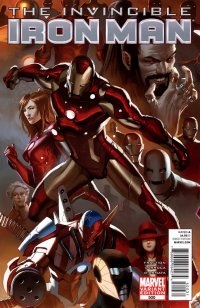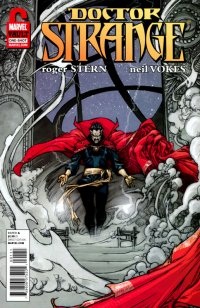 Robert E. Howard’s Savage Sword #1 (Dark Horse, $7.99)
Robert E. Howard’s Savage Sword #1 (Dark Horse, $7.99)
By Adam Prosser
The Savage Sword of Conan began in 1974, in the wake of the newly resurgent popularity of the character, as an attempt to tell even grittier stories outside the Comics Code Authority. It was one of the most popular comics magazines of the 70s, and astonishingly, it came out consistently until 1995, when the Marvel bankruptcy finally scotched it. That same bankruptcy allowed Dark Horse to snag the rights to the character, and after a brief hiatus, the barbarian proved to be as popular as ever when his comic was relaunched in 2003. He’s since been joined by a number of Robert E. Howard’s other creations, all of whom have met with relative success, so clearly it’s time to relaunch Savage Sword as well. It’s like the 70s never ended!
Of course, with the comics code authority recently laid in its grave, the exact reasoning for relaunching this magazine is a little less clear. The idea seems to be to continue the parade of Conan miniseries that Dark Horse had going until recently, combined with a showcase for other Howard characters who may not rate their own books, and reprints of Howard-related comics material. So it’s the book for “out-of-continuity” Conan and other Robert E. Howard stories by writers and artists who aren’t on the main title, and maybe even a potential showcase for new creators. Potentially very exciting…but the results are a little muddled.
Don’t get me wrong, there’s some good stuff here; Howard’s work always seems to bring out the best in adventure comics artists, and the work here is mostly up to the high standards set by the earlier version of this magazine—the possible exception being “Storytelling”, a story featuring a sixteenth-century female warrior named Dark Agnes, and even then Robert Atkins’ pencils and Rebecca Buchman’s inks don’t really sink below “mediocre”. The most striking art, though, belongs to “Worms of the Earth”, a recolored reprint of an older story featuring Bran Mak Morn by the legendary Howard adapters Barry Windsor-Smith and Tim Conrad (with Roy Thomas completing the trifecta on script duties). The art is weird, dark and striking, truly conveying the barbaric nature of its protagonists and the Lovecraftian horror that creeps in at the edges (with a few specific shout-outs to Lovecraft in the dialogue). Given that this story takes up almost half the book’s 80s pages, it justifies the purchase of the book in and of itself.
Unfortunately, this comic falls into a trap that far too many anthologies tend to do: too many of the stories are “to be continued”, lending the whole thing a half-finished air. ONE serial would be acceptable, but this book presents us with two, plus a (rather confusing) story that continues the continuity of Dark Horse’s first Solomon Kane miniseries but doesn’t actually feature the title character, and a fairly unenlightening text piece about Howard’s character El Borak. Taken together, it creates the impression of a half-finished publication thrown together at the last minute, which is unfortunate.
Still, like everything else Dark Horse has published with Howard’s name on it, the results are consistently of a higher quality than a lot of the stuff the Big Two regularly foist on us. The “Howardverse” is one of several lines (along with the Hellboy books and some of their licensed books) that Dark Horse has quietly turned into solid, consistent sellers with a devoted audience, which strikes me as exactly the kind of stability that the comics industry needs right now. Whatever its flaws, any addition to that paradigm is welcome right now. If it worked in the 70s, maybe it can work again.
Rating: 




Out of a Possible 5 Stars
 The Invincible Iron Man #500 (Marvel, $4.99)
The Invincible Iron Man #500 (Marvel, $4.99)
By Jeb D.
I don’t think I’d realized it, but it was beginning to bug me that every Marvel special or milestone book was being filled out with reprint material. Often quite good (you’ll look long and hard to find a better gods-and-heroes comic story than Simonson’s “Like a Bat Out of Hel!,” that padded out Thor:God-Sized), but given the wealth of talent that the House of Ideas deploys (or misuses, depending on your point of view), it’s nice to see an anniversary celebrated with an engaging epic tale nearly 60 pages long for your five bucks.
“The New Iron Age” is one of those future-dystopia stories so beloved of Marvel. The currently brain-addled Tony Stark cannot remember the details of having created a dreadful weapon. As he and Peter Parker try to reconstruct the past, and grapple with its implications, the story shifts to a devastated future world where Stark’s weapon has brought humanity to the verge of extinction.
That the face of future evil would be The Mandarin isn’t really all that spoilery (who else would be the villain in what could be Shellhead’s ultimate showdown?), but I’ll let the reader enjoy meeting the various members of the human survivors that are either serving the Mandarin, or fighting for their lives against monstrous futuristic tech, while trying desperately to put in place Stark’s long-lost “doomsday” plan.
Matt Fraction, as usual, handles the various story elements smoothly, integrating Stark and Parker’s low-key intellectual give and take; the showdown with a terrorist group (whose origin is delightfully amusing) contrasting the all-business Iron Man with the unexpected appearance of a Spider-Man who actually manages, thanks to Fraction, to make his in-fight banter funny; and the future time threads. The story’s themes of power and responsibility resonate, and while Fraction does lend himself an emotional helping hand by culminating the story with a gripping “last stand,” he keeps the action moving, and the characterization sufficiently strong, that the reader feels genuine emotion, not manipulation.
I remain one of Salvador Larroca’s greatest not-exactly-fans (most of the sequence of Tony and Peter out of costume looks like the characters are made of plastic), but with the help of colorist Frank D’armata, he aquits himself well enough when the fists are flying. The future segments are broken down by character, and handled respectively by Nathan Fox and Javier Rodriguez, Carmine Di Giandomenico and Matthew Wilson, and Kano: each brings a special touch to his section; worth singling out is di Gandomenico’s icy-cold treatment of the Mandarin, triumphant at last over his old enemy. The book also comes with a 6-page preview of Iron Man 2.0 #1; can’t say much about so little of Nick Spencer’s script, but I’m looking forward to seeing lots of Stark tech drawn by Barry Kitson.
Rating: 




Out of a Possible 5 Stars
 FROM THE VAULT #1: DOCTOR STRANGE (Marvel, $2.99)
FROM THE VAULT #1: DOCTOR STRANGE (Marvel, $2.99)
By Jeb D.
Given the vagaries of the comic publishing business, it’s only logical that the Big 2 would be sitting on a treasure trove of failed projects, cancelled orphans, etc. From the Vault is a new series that will showcase such odds and ends.
It launches with a leftover from a previous failed anthology series: 1996’s The Marvel Universe series was a slightly misbegotten idea from the same conceptual misstep that brought us The Sentry: tales of familiar Marvel characters in the days before FF#1 and Amazing Fantasy #15 (in other words, stories where, by definition, nothing of particular significance can happen).
It’s a fun idea-we all love “previously unreleased” stuff-and that’s what this first issue is: it’s fun. Nothing wrong with fun, of course… but there’s a certain redundancy to this fun, since this story of Stephen Strange finding his Greenwich Village sanctum devotes a fair amount of time to once more running down his familiar origin story. As you’d imagine, a sorcerer’s search for lodgings will turn out to be anything but a simple house-hunting expedition, and writer Roger Stern spins a brisk, breezy yarn of necromancy and mystical beasties: he’s got a nice feel for making magical spells feel almost logical, and the dialog is straightforward without feeling overly simplistic.
Of course, the cartoony early-60’s Ditko style that is called for was the trademark of artist Neil Vokes back in his Untold Tales of Spider-Man days, and, abetted by inker Jay Geldhof and colorist Leigh Loughridge, he steps up with wonderful blocks and bolts of astral-plane ectoplasm, and the sort of “mystical” geometry that made Doctor Strange such a hit with the more liberal-minded of 60’s readers. It doesn’t add up to anything particularly memorable, but if you’re feeling nostalgic for the vintage days of Strange Tales, it’ll bring back some memories.
I have no idea what else Marvel has floating around in the bin (were there any leftovers after Slott’s Thing series was cancelled?), but my guess is that the quality will vary pretty widely. If that’s the case, here’s hoping that this entertaining little diversion is closer to the middle of the pack than the top in that regard.
Rating: 




Out of a Possible 5 Stars